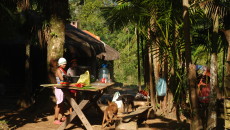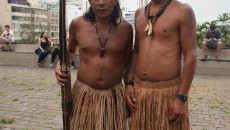By Renata Bessi and Santiago Navarro F.
America’s Program
The Brazilian Ministry of Justice emphatically affirmed, “all of the proceedings to identify and demarcate the lands of the indigenous Jaragua Guaraní in the city of São Paulo have been undertaken with the participation of the indigenous community, in accordance with the UN International Labor Convention 169,” in an interview with the Americas Program.
Brazil is a signatory to Convention 169 which, among other things, guarantees the right to free determination of indigenous towns, such as “the right to decide their own priorities in terms of the development process and the extent to which it affects their lives, beliefs, institutions and spiritual well-being and the lands they live on or use in some way, and for controlling, to the extent possible, their own economic, social and cultural development. What’s more, the peoples should be able to participate in the formation, application and evaluation of the national and regional development plans and programs that are likely to directly affect them.”
Indigenous people question the federal government’s version, arguing that they haven’t been called upon to participate in an effective way in the demarcation process of their lands. Beyond that, a fundamental point throws into question the right to self-determination of these people in terms of how they possess the land.
The geographer and researcher from the University of São Paulo, Camila Salles de Faria, tells the Americas Program that in Brazil there are only two modalities for possessing land, a public and a private one. According to her, although indigenous lands will be recognized through demarcation of space, the land does not actually belong to the indigenous people, since in Brazil’s legal system communal or collective property does not exist, thus it remains beneath the jurisdiction of the state, and if at any moment it decides to interfere in the area, it is able to.
“Indigenous lands are part of the Union, that is to say, they are public property that are under the jurisdiction of the State, like the forests. Thus, indigenous people only have the right to use the land,” says the researcher.
“Brazil signed the ILO Convention 169, but is violating the accord, because although the constitution has advanced in some cases, indigenous territory remains under the guardianship of the federal government and that is a form of interference. It even interferes with the ethnic recognition process, because a federal entity [Funai] determines who is an indigenous individual and who isn’t,” states Karay Popygua, one of the youngest Guaraní leaders in the town of Tekoa Pyau, in an interview.
Currently, in Brazil an intensification of the conflict is playing out between indigenous people and capitalist logic, which sees the land as one more product to be offered on the market and has fragmented indigenous territories. This contrasts with the way that indigenous people use the land, which they see as part of their life and thus as part of reproduction of themselves, which is materialized in their culture, in ceremonies and daily relationships.
Brazil without agrarian reform
According to Salles, a historical context exists for the formation of land ownership in Brazil that should not be forgotten.
“When the Portuguese arrived, they divided the lands into what were called colonies, a Portuguese model that was copied for Brazil, fundamentally based on the division of the land. The crown was the owner of the land and the only one with the power to give land titles. Afterward, the State began to legalize these lands that were being illegally appropriated, but without a process of agrarian reform,” she explains.
“So property came about not as a constitutional right, but as an appropriation and imposition by those who were in power on a local level, and those who already had land and were able to obtain more.” The result is that “the concentration of land through the forced removal of indigenous people generated other economic and political power.”
Throughout the military dictatorship in Brazil, law 4504 was passed concerning land statutes, which was the first official document that addressed the topic of agrarian reform in Brazil. This law was diluted in order to strengthen and grow large land estates, which gave way to an increase of technology and industrialization in agriculture. This was the first reordering of territory that formed the platform for the Green Revolution. Today, this model has a monopolistic control over many lands that are used to grow monocultures– soy, sugar cane, and eucalyptus, that is based on the approach of industrial food biofuel production under the “green” guise of sustainability.
“The concentration of property and the possession of land was the first strategy. The second was the expulsion of small-scale farmers and indigenous people in order to transform them into potential consumers for the industrial food industry. This opened the possibility of agribusiness expanding rapidly within a short period of time, concentrating the monopoly over food production and land ownership in the hands of a dozen corporations, among which are the vulture investors Gustavo Grobocopatel and George Soros, along with the Elszstein family, Coca Cola, Pepsi-Cola, Nestlé, Cargill, among others,” says Sebastiao Pinheiro, agronomist and researcher with the Federal University of Rio Grande do Sul, to the Americas Program.
In the case of the Guaraní, especially in the south and southeastern parts of Brazil, Salles explains that throughout the 20th century, it became common practice for non-indigenous people to call themselves “owners” of the zones where the Guaraní lived and then “permit” the use of the land, with the objective of later acquiring documentation of effective ownership and then converting it into private property. Before taking possession of the land, the supposed landowners “requested” that indigenous people leave their lands, often using threats and judicial mechanisms in order to take possession of the land.
The land demarcation model
The Funai was created with the law 5371 in 1967 and has as its principal function maintaining the protection of indigenous lands and natural resources. It has functioned as a sort of bridge between the government and indigenous communities to promote the demarcations of land, following the requirements established by decree 1775/96, which requires a series of elements before the executive branch can recognize as indigenous any piece of land, and the majority of these elements are in the hands of the Funai. Among them are: the study and identification and creation of borders; physical demarcation; surveys of the validation of the land by non-indigenous occupants; declaration of limits, which is in the hands of the Ministry of Justice; the official approval of the demarcation, which is controlled by Brazil’s president.
Since the colonial period Brazil recognized the rights of people who were already living in the territory, with the so-called “rights of origin,” but it was never legally demarcated. It wasn’t until the beginning of the 20th century, specifically in 1910, that an indigenous government entity was created—the Service for Indigenous Protection (SPI)—which is when the demarcation of indigenous territory began. This was done from an integrationist point of view, with the objective that indigenous people would cease being indigenous. With that there was a demarcation of small areas, which were barely enough for living space, and with the growth of the population people were pushed to live in deplorable conditions.
The Indian Statute of 1973 predicted that indigenous people would be the responsibility of the Funai until they slowly became fully integrated into Brazilian society. Being indigenous would be a condition in transition. “However this diagnostic that indigenous people would cease to be indigenous and that they wouldn’t need more land, didn’t end up happening,” explains Juliano Silva, a member of the Funai in Marabá, in the state of Pará, to the Americas Program.
With the 1989 constitution, new legal framework was established for the demarcations that theoretically guaranteed that a territory was sufficient for the material and non-material reproduction of indigenous culture. “The demarcation was a dispute between the forces of the time. It was through the legal regime that they were able to guarantee minimal conditions for indigenous people, although it wasn’t the ideal situation for these populations,” say the anthropologist María Inés, from the Indigenous Labor Center (CTI).
For the researcher and agronomist Sebastião Pinheiros, the policies of integration and of respect for ethnic groups are merely a theory in Brazil. “This is very sad and dramatic. The development tendency in Brazil with regard to indigenous people is one of either being incorporated or disappearing. In Rio Grande do Sul, for example, in 1960 there were at least 50 indigenous areas; today only 4 remain and the thousands of hectares of indigenous land don’t even reach one hundred and that happened in today’s Brazil.”
Resistence to the demarcations
Salles points out that since the 1980s the demarcations were not always accepted by the Guaraní, since the space was defined by the state and confined by the limits imposed by signs, fences, and even walls. “Due to the fear that their way of life would be controlled from the outside, many times they preferred to abandon the places they were living. However, currently, confronted with the recurring expropriations and expulsions, demarcation is a resource available to them in order to preserve their traditions, resisting and maintain this fight for space,” affirms the geographer.
Although indigenous people are not happy with everything done by the Funai, they consider the demarcation of their lands to be a last resource available to them so that they don’t disappear entirely, and this has to be promoted by the institution. According to Casé Angatu, of indigenous descent from the town Tupinamba, the problems with all the indigenous groups today in Brazil are the demarcations of their lands, which is a process that has come to a halt, and to make matters worse, the body that had the principal function of mediating these processes, the Funai, is being phased out by the government. “There is currently a bill for a constitutional amendment, of the constitution of 1988, the Pec 215-A, which says that congress has the last word on the demarcation of our lands and we are radically opposed to this, because the congress is made up on individuals who have the firepower, the votes, and the money,” says Casé Angatu.
Before the elections on October 5, the Brazilian Association of Indigenous Peoples (APIB) put forth an open letter to the candidates for the presidency, denouncing the favoritism of the government for sectors connected to agroindustry, mining, timber, to the contractors and large businesses that have had an impact on indigenous lands. In the same way they demand that international agreements signed by Brazil be respected, such Convention 169, in terms of indigenous rights and culture, as well as the UN Declaration regarding the rights of indigenous peoples.





